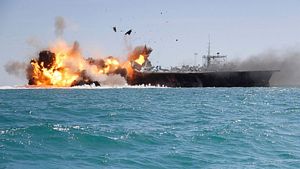This week, Iranian television broadcasted a video showing the destruction of a U.S. warship replica near Larak Island, close to the strategically vital entrance to the Strait of Hormuz, during a recent military exercise by the country’s elite Revolutionary Guard. The military exercise, codenamed “Great Prophet 9,” was conducted by the naval branch of the Revolutionary Guard Corps and was meant to showcase Iran’s anti-access/anti-denial (A2/AD) capabilities.
Gen. Mohammad Ali Jafari, the highest commander of the Islamic Revolutionary Guards Corps, boastfully told the local media during the “Great Prophet 9” exercise: “A unique power has been created, and we do not like to put it into practice. But if, God forbid, such a day comes, Iran’s navy will have the complete control over the Sea of Oman, the Hormuz Strait and the Persian Gulf.”
The Revolutionary Guards’ navy chief, Adm. Ali Fadavi, stated on state television that, “American aircraft carriers are very big ammunition depots housing a lot of missiles, rockets, torpedoes and everything else,” and added that a direct hit by a missile could set off a large secondary explosion within America’s capital ships, according to the New York Times. Fadavi also noted in the past that his forces are capable of sinking an American aircraft carrier in a future military confrontation with the United States.
In the video, the U.S. Nimitz aircraft carrier replica, constructed already a year ago, is hit multiple times with various missiles among them the Fateh-110. The Fateh A-110 is a short-range, road-mobile, solid-propellant ballistic missile. Iranian sources claim that the missile, capable of carrying a 500 kg payload, is highly accurate. However, according to the Missile Threat database: “Although Iran has improved the missile’s overall ability, its accuracy makes the Fateh A-110 ineffective against moving military targets. However, the missile is capable of hitting most large military targets such as bases and airfields.”
Perhaps, the missiles that hit the aircraft carrier mockup were also improved versions of the Fateh A-110, which are believed to be in development. A report by the Center for Strategic and Budgetary Assessments (CSBA) on Iran’s A2/AD threat notes: “Should Iran improve the accuracy of the Fateh-110A, the agility conferred by its smaller size and solid-fuel motors could make it an effective and relatively survivable short-range strike system.”
The CSBA report also summarizes Iran’s general A2/AD capabilities:
“Iran’s A2/AD capabilities can be grouped into four broad categories: ballistic missiles, some of which could be armed with WMD warheads; unconventional warfare and terrorism by proxy, possibly made more lethal by G-RAMM weapons; maritime exclusion systems such as mines, ASCMs[anti-ship cruise missiles], and fast attack craft; and air defenses.”
During the recent military exercise, Iran apparently made use of a large section of the A2/AD arsenal outlined above. In addition to ballistic missiles, Iranian speedboats laid M-08 contact mines to limit the “carriers” maneuverability, fired 107-millimeter rockets, and small cruise-missiles. Furthermore, Iranian-made Noor missiles as well as a C-704K anti-ship cruise missile were launched against the carrier. To finally finish the target off, a remotely-controlled suicide boat filled with 1000 kg of high-explosives was rammed into the 1:1 Nimitz mock-up.
The constricted waters of the Strait of Hormuz and the Persian Gulf pose significant challenges to U.S. vessels and make Iranian smarming tactics, mines and short-range missiles especially effective. Nevertheless, the recently broadcasted video provides no clues whether Iranian forces are capable of penetrating the multi-layered defenses of an U.S. aircraft carrier strike group, for the simple fact that the escort warships of the carrier were missing from the exercise. As such, “Great Prophet 9” can be classified as a simple propaganda demonstration.
Hence, perhaps also the U.S. Navy’s laconic response: “We are aware of a recent exercise by Iranian naval forces involving a mock-up of a vessel similar to an aircraft carrier. We are confident in our naval forces’ ability to defend themselves against any maritime threat,”said Department of Defense spokeswoman Elissa Smith.

































